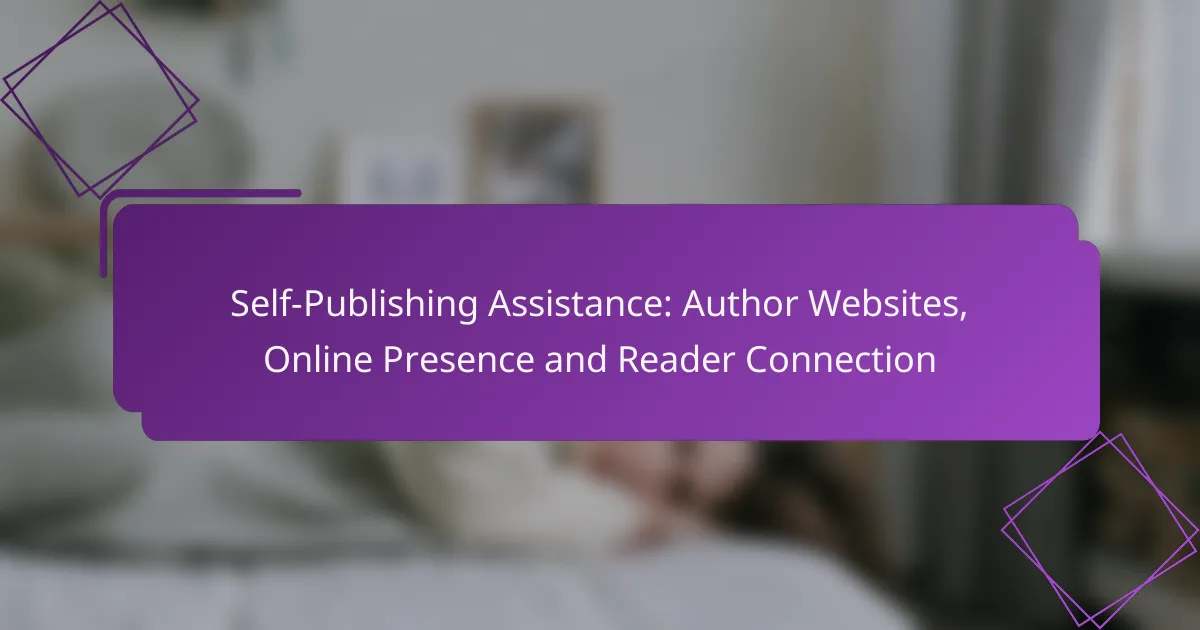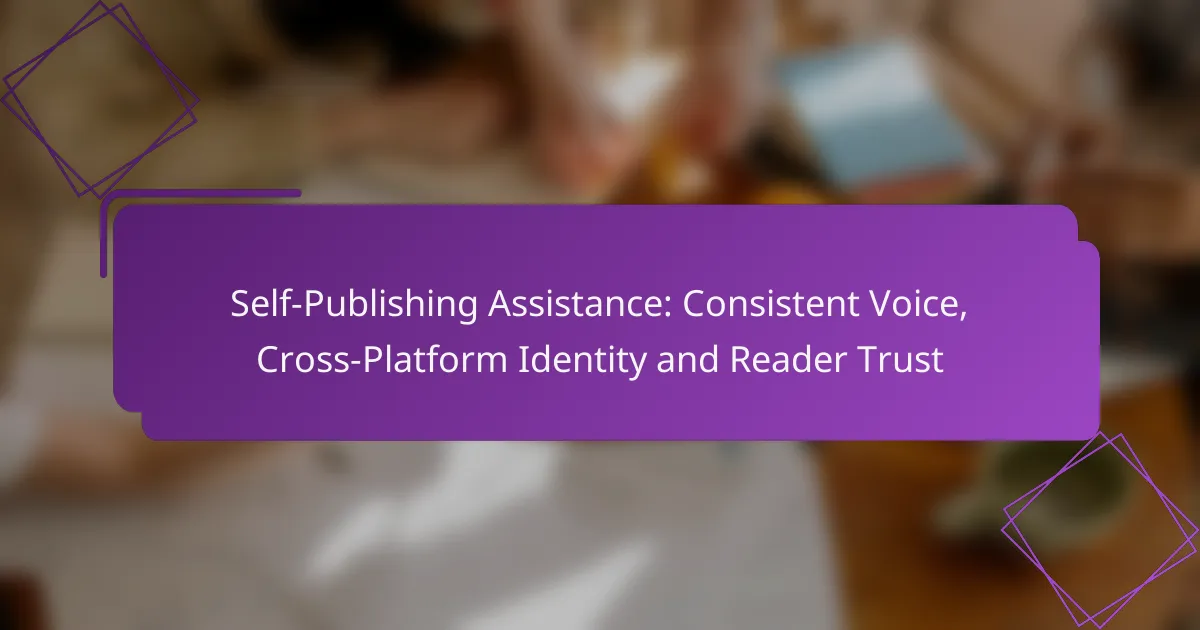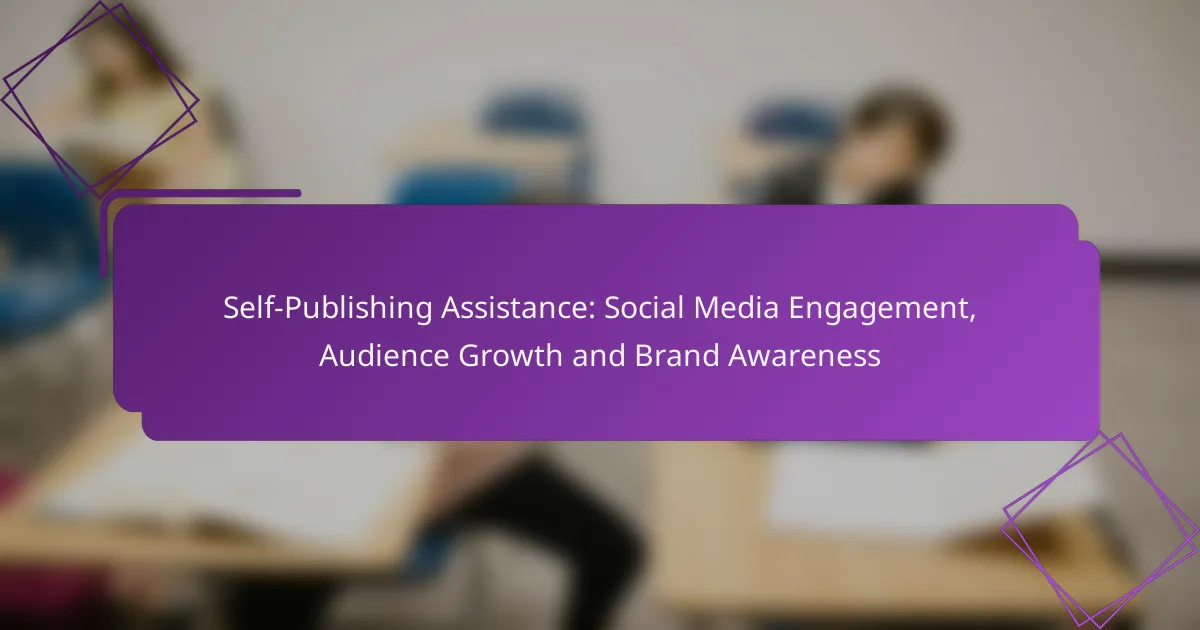Self-publishing authors can significantly enhance their visibility and reader engagement by establishing a professional online presence. By creating an intuitive website, leveraging social media, and utilizing newsletters, authors can effectively connect with their audience and promote their work. Implementing these strategies not only fosters relationships with readers but also helps build credibility in the competitive literary market.

How can self-publishing authors build an effective online presence?
Self-publishing authors can build an effective online presence by creating a professional website, utilizing social media, engaging with readers through newsletters, and optimizing their content for search engines. These strategies help authors connect with their audience, promote their work, and establish credibility in the literary market.
Creating a professional author website
A professional author website serves as a central hub for your online presence. It should include essential elements such as a biography, book listings, a blog, and contact information. Ensure the design is clean and user-friendly, making it easy for visitors to navigate.
Consider using platforms like WordPress or Wix, which offer customizable templates tailored for authors. Include a domain name that reflects your author brand, ideally your name or a unique title related to your writing. Regularly update your website with new content to keep readers engaged.
Utilizing social media platforms
Social media platforms like Facebook, Twitter, and Instagram are vital for self-publishing authors to reach and engage with readers. Choose platforms that align with your target audience; for instance, Instagram is great for visual storytelling, while Twitter can be effective for quick updates and interactions.
Post consistently and interact with your followers by responding to comments and messages. Share insights about your writing process, updates on new releases, and personal anecdotes to build a connection with your audience. Consider using hashtags relevant to your genre to increase visibility.
Engaging with readers through newsletters
Newsletters are an effective way to maintain direct communication with your readers. Use platforms like Mailchimp or Substack to create and manage your email list. Offer incentives for sign-ups, such as exclusive content, sneak peeks of upcoming books, or discounts on purchases.
Send regular newsletters that include updates about your writing, upcoming events, and curated content that interests your readers. Keep the tone friendly and personal to foster a sense of community among your subscribers.
Optimizing for search engines
Search engine optimization (SEO) is crucial for increasing the visibility of your author website. Start by conducting keyword research to identify terms your potential readers are searching for. Incorporate these keywords naturally into your website content, including titles, headings, and meta descriptions.
Additionally, focus on creating high-quality content that provides value to your audience. Regularly update your blog with relevant articles, book reviews, or writing tips. Building backlinks from reputable sites can also enhance your site’s authority and improve its ranking on search engines.

What are the best practices for author websites?
Best practices for author websites focus on creating a professional and engaging online presence that connects with readers. Key elements include a memorable domain name, intuitive navigation, and a blog for regular updates.
Choosing the right domain name
Selecting a suitable domain name is crucial for your author website’s identity. Aim for a name that reflects your brand, is easy to remember, and ideally includes your author name or book title.
Keep it short and avoid complex spellings. A .com extension is often preferred, but .net or .author can also work if they fit your brand. For example, if your name is Jane Doe, consider domains like JaneDoeBooks.com or JaneDoeAuthor.com.
Designing user-friendly navigation
User-friendly navigation enhances the visitor experience on your author website. Ensure that your menu is clear and straightforward, allowing readers to easily find sections like your bio, book listings, and contact information.
Consider using dropdown menus for subcategories, but keep them limited to avoid overwhelming visitors. A good rule of thumb is to limit main menu items to five or six, ensuring each link is descriptive and relevant.
Incorporating a blog for updates
A blog is an effective way to keep your audience engaged and informed about your writing journey. Regular posts can include updates on new releases, behind-the-scenes insights, or discussions on writing techniques.
Aim to publish at least once a month to maintain reader interest. Use categories and tags to organize your content, making it easier for visitors to find topics that resonate with them. Engaging with comments can also foster a sense of community among your readers.
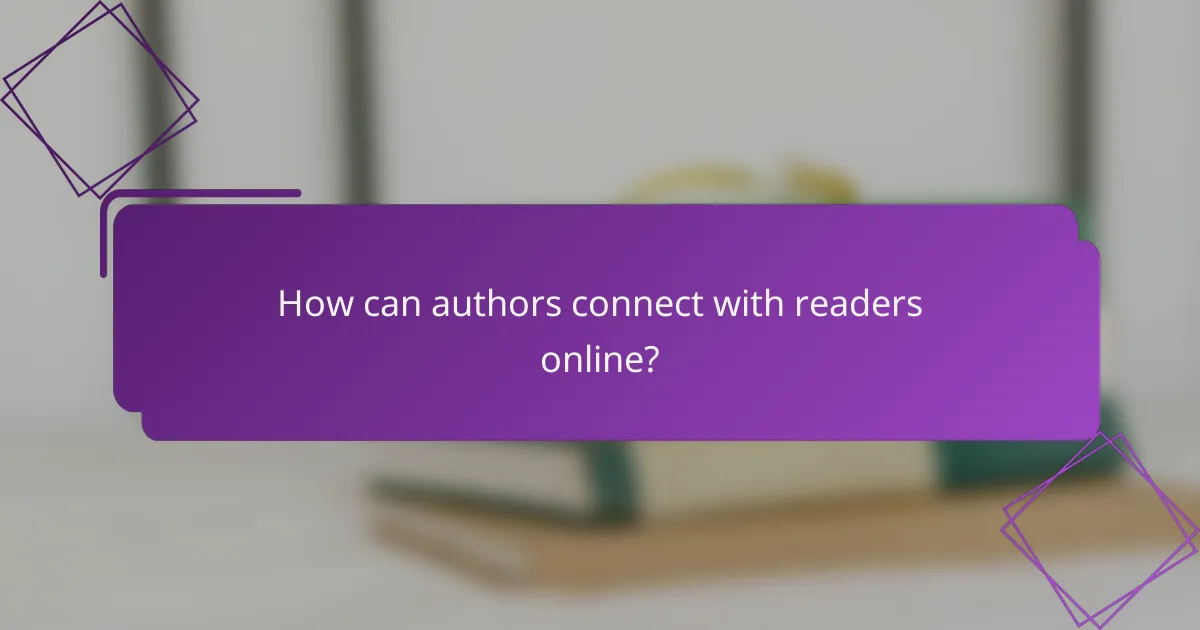
How can authors connect with readers online?
Authors can connect with readers online through various strategies that enhance visibility and engagement. Building a strong online presence, utilizing email marketing, and participating in community events are effective ways to foster relationships with readers.
Building an email subscriber list
Creating an email subscriber list is essential for authors to maintain direct communication with their readers. This list allows authors to share updates, new releases, and exclusive content, fostering a sense of community and loyalty.
To build your list, consider offering a freebie, such as a short story or a chapter from your book, in exchange for email sign-ups. Use platforms like Mailchimp or ConvertKit to manage your subscribers and send newsletters efficiently.
Hosting virtual book events
Virtual book events, such as readings or Q&A sessions, provide authors with a platform to engage directly with their audience. These events can be hosted on platforms like Zoom or Facebook Live, allowing for real-time interaction.
Promote your event through social media and your email list to maximize attendance. Consider scheduling events around book launches or significant dates to generate excitement and participation.
Participating in online book clubs
Joining online book clubs can significantly enhance an author’s visibility and reader connection. These clubs often seek authors for discussions, providing a unique opportunity for authors to share insights and engage with readers.
Look for book clubs on platforms like Goodreads or Facebook, and reach out to them with a proposal to participate in a discussion about your work. Be prepared to answer questions and interact with readers to create a lasting impression.

What tools can assist in self-publishing?
Several tools can significantly aid in self-publishing, enhancing your online presence and connecting with readers. These tools range from publishing platforms to design software, each serving a unique purpose in the self-publishing journey.
Using platforms like Amazon Kindle Direct Publishing
Amazon Kindle Direct Publishing (KDP) is a popular platform that allows authors to publish eBooks and paperbacks directly to Amazon. This service provides a straightforward process, enabling authors to upload their manuscripts, set prices, and reach millions of readers globally.
When using KDP, consider the royalty options available, which typically range from 35% to 70% depending on your pricing strategy. It’s essential to format your book correctly and utilize the platform’s promotional tools to maximize visibility.
Leveraging services like IngramSpark
IngramSpark is a distribution service that offers authors the ability to publish print and eBooks to a wide network of retailers and libraries. This platform is particularly beneficial for authors looking to reach a broader audience beyond Amazon.
While IngramSpark has a setup fee, it provides access to numerous distribution channels, which can significantly enhance your book’s availability. Authors should ensure they understand the pricing structure and consider the potential return on investment based on their target market.
Employing design tools like Canva
Canva is a versatile design tool that can help authors create eye-catching book covers, promotional materials, and social media graphics. Its user-friendly interface allows even those without design experience to produce professional-looking visuals.
When using Canva, take advantage of its templates specifically designed for book covers and marketing materials. Ensure your designs align with your book’s genre and target audience to effectively attract potential readers.
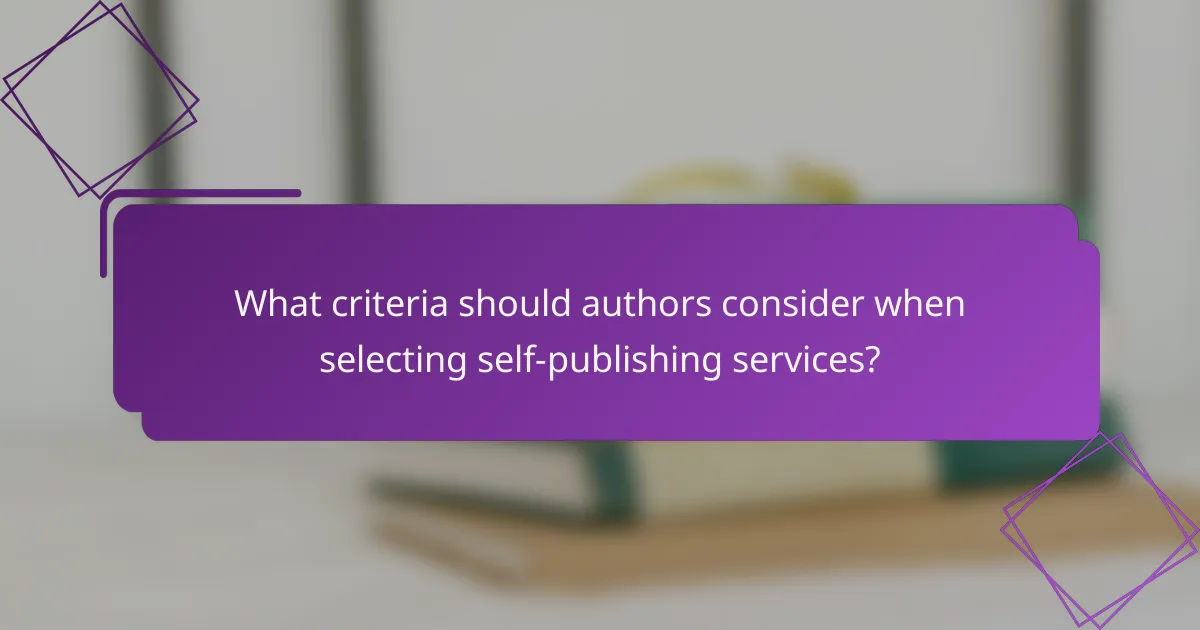
What criteria should authors consider when selecting self-publishing services?
Authors should consider factors such as distribution options, pricing structures, and customer support quality when selecting self-publishing services. These criteria can significantly impact the success of their published work and their overall experience in the self-publishing process.
Evaluating distribution options
Distribution options determine how widely and effectively your book reaches readers. Look for services that offer both digital and print distribution across major platforms like Amazon, Barnes & Noble, and independent bookstores.
Consider whether the service provides global distribution or is limited to specific regions. A service with wider reach can enhance visibility, while localized services may better target specific audiences.
Comparing pricing structures
Pricing structures can vary significantly among self-publishing services, often including upfront fees, royalties, or a combination of both. Some platforms may charge a flat fee for publishing, while others take a percentage of sales.
Evaluate what is included in the pricing, such as editing, cover design, and marketing support. It’s essential to calculate potential earnings based on different pricing models to find the most financially viable option for your book.
Assessing customer support quality
Quality customer support is crucial for authors navigating the self-publishing landscape. Look for services that offer multiple support channels, such as email, chat, and phone, along with accessible resources like FAQs and tutorials.
Read reviews and testimonials to gauge the responsiveness and helpfulness of customer support teams. A service with strong support can help resolve issues quickly, making the self-publishing process smoother and less stressful.
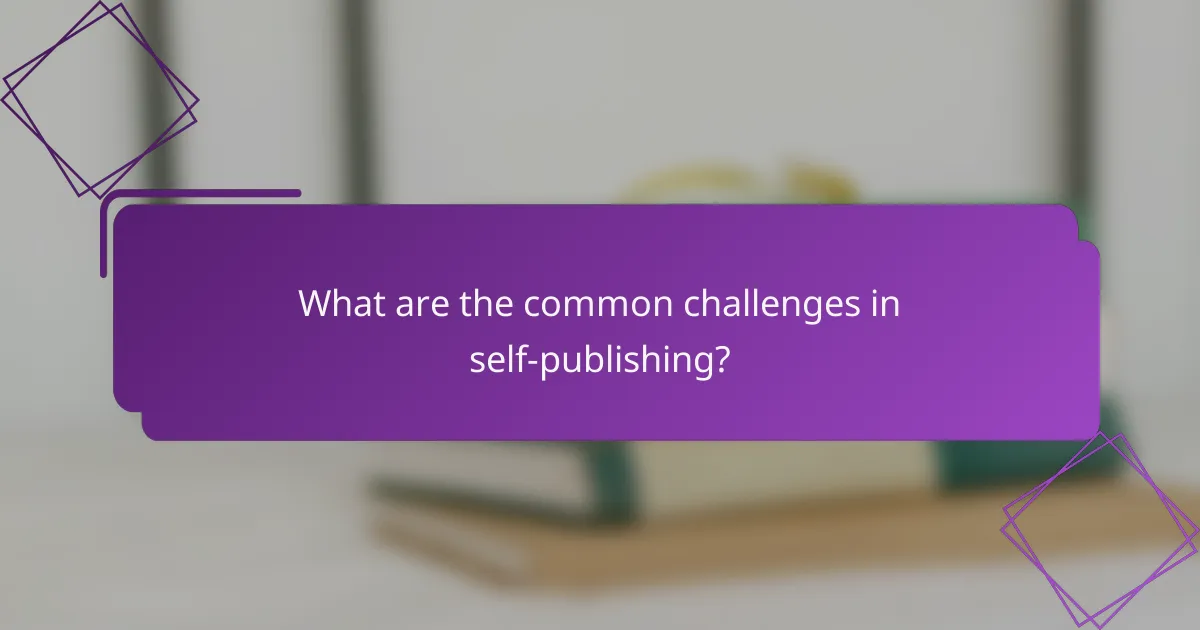
What are the common challenges in self-publishing?
Self-publishing presents several challenges, including navigating copyright issues and managing effective marketing efforts. Authors must address these hurdles to successfully connect with readers and establish a robust online presence.
Navigating copyright issues
Copyright issues are a significant concern for self-published authors. Understanding copyright laws is crucial to protect your work from unauthorized use and to ensure you have the rights to any content you include, such as images or quotes from other authors.
To navigate these issues, consider registering your work with the U.S. Copyright Office or a similar organization in your country. This provides legal proof of ownership and can deter infringement. Always seek permission for any third-party content you wish to use, as this can prevent potential legal disputes.
Managing marketing efforts
Effective marketing is essential for self-published authors to reach their target audience. This includes building an online presence through social media, author websites, and email newsletters. Establishing a clear marketing strategy can help you allocate your resources effectively.
Consider utilizing platforms like Facebook, Instagram, or Goodreads to engage with readers. You might also explore paid advertising options, which can range from modest budgets to more substantial investments, depending on your goals. Regularly assess your marketing efforts and adjust your strategies based on what resonates with your audience.
